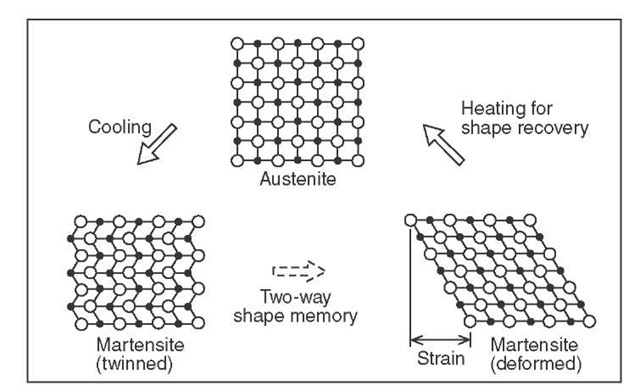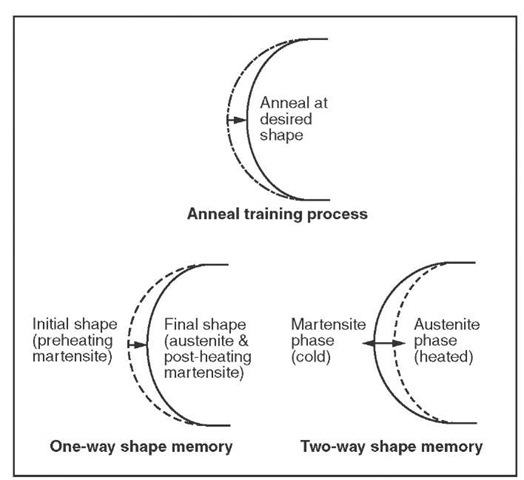These are a group of metallic materials that can return to some previously defined shape or size when subjected to the appropriate thermal procedure. That is, shape memory alloys (SMA) can be plastically deformed at some relatively low temperature and, upon exposure to some higher temperature, will return to their original shape. Materials that exhibit shape memory only upon heating are said to have one-way shape memory, whereas those that also undergo a change in shape upon recooling have a two-way memory. Typical materials that exhibit the shape memory effect include a number of copper alloy systems and the alloys of gold-cadmium, nickel-aluminum, and iron-platinum.
A shape memory alloy may be further defined as one that yields a thermoelastic mar-tensite, that is, a martensite phase that is crystallographically reversible. In this case, the alloy undergoes a martensitic transformation of a type that allows the alloy to be deformed by a twinning mechanism below the transformation temperature. A twinning mechanism is a herringbone structure exhibited by martensite during transformation. The deformation is then reversed when the twinned structure reverts upon heating to the parent phase.
Transformation Characteristics
The martensite transformation that occurs in shape memory alloys yields a thermoelastic martensite and develops from a high-temperature austenite phase with long-range order. The martensite typically occurs as alternately sheared platelets, which are seen as a herringbone structure when viewed metallographi-cally. The transformation, although a first-order phase change, does not occur at a single temperature but over a range of temperatures that is characteristic for each alloy system.
There is a standard method of characterizing the transformation and naming each point in the cycle. Most of the transformation occurs over a relatively narrow temperature range, although the beginning and end of the transformation during heating and cooling actually extends over a much larger temperature range. The transformation also exhibits hysteresis in that the transformation on heating and on cooling does not overlap. This transformation hysteresis varies with the alloy system.
Thermomechanical Behavior and Alloy Properties
The mechanical properties of shape memory alloys vary greatly over the temperature range spanning their transformation. The only two alloy systems that have achieved any level of commercial exploitation are the nickel-titanium alloys and the copper-base alloys. Properties of the two systems are quite different. The nickel-titanium alloys have greater shape memory strain, tend to be much more thermally stable, have excellent corrosion resistance compared to the copper-base alloys, and have higher ductility. The copper-base alloys are much less expensive, can be melted and extruded in air with ease, and have a wider range of potential transformation temperatures. The two alloy systems thus have advantages and disadvantages that must be considered in a particular application.
Materials
The most common shape memory alloy material is Nitinol, an acronym for Ni (nickel)-Ti (titanium)-NOL (Naval Ordnance Laboratory). As suggested by the name, the material consists of approximately equal parts of nickel and titanium and was originally developed by the Naval Ordnance Laboratory.
Two different phases, martensite and aus-tenite, are typically associated with the crystalline structure of shape memory alloys. The aus-tenite phase is a highly ordered phase that occurs above a certain transition temperature. In this phase, the crystalline bonds must be at right angles with one another, as shown in the upper sketch in Figure S.2. The martensite phase occurs below the transition temperature, and right angle bonds are not required, as indicated by the twinned case in Figure S.2 (lower left). The lower right of the figure shows that strain is required to achieve a particular alignment, since the martensite phase is not in an ordered state.
The term shape memory is derived from the fact that a shape memory alloy can recover its original shape when heated above a certain transition temperature. Before a shape memory alloy such as Nitinol can present shape memory behavior, it must first be trained. The training process is illustrated in the upper drawing of Figure S.3, in which the shape memory alloy is annealed while it is constrained in the shape that it is to memorize. From a microscopic view, this corresponds to the austenite phase. For the Nitinol wire, the annealing process corresponds to a contraction in the length of the wire. After annealing, the material is said to have a oneway shape memory.
The Nitinol recovers its memorized shape when heated above the transition temperature and will remain in that shape upon cooling (lower left of Figure S.3). For the shape memory alloy to return to its initial shape, an external force must be applied to deform it. The two-way shape memory (lower right of Figure S.3) corresponds to a martensite phase to austenite phase by heating (shape recovery) followed by a mechanically produced deformation of the material upon cooling.
FIGURE S.2 Microscopic view of shape memory process.
Applications
The manufacturing and the technology associated with both of the two commercial classes of shape memory alloys are quite different as are the performance characteristics. Therefore, in applications where a highly reliable product with a long fatigue life is desired, the nickel-titanium alloys are the exclusive materials of choice. Typical applications of this kind include electric switches and actuators. However, if high performance is not mandated and cost considerations are important, then the use of copper-zinc-aluminum shape memory alloys can be recommended. Typical applications of this kind include safety devices such as temperature fuses and fire alarms.
Heating a shape memory alloy product to a temperature above some critical temperature is not recommended. The critical temperature for nickel-titanium is approximately 250°C, and for copper-zinc-aluminum approximately 90°C. Extended exposure to thermal environments above these critical temperatures results in an impaired memory function regardless of the magnitude of the load.
Another technical consideration in the practical application of shape memory alloys pertains to fastening or joining these materials to conventional materials. This is a significant issue because shape memory alloys undergo expansions and contractions not encountered in traditional materials. Therefore, if shape memory alloys are welded or soldered to other materials, they can easily fail at the joint when subjected to repeated loading. Alloys of nickel-titanium and copper-zinc-aluminum can also be brazed by using silver filler metals; however, the brazed region can fail because of cyclic loading. It is therefore desirable to devise some other mechanism for joining shape memory alloys to traditional materials. Shape memory alloys cannot be plated or painted for similar reasons.
Free Recovery
In this case, a component fabricated from a shape memory alloy is deformed while marten-sitic, and the only function required of the shape memory is that the component return to its previous shape upon heating. A prime application is the blood-clot filter in which a nickel-titanium wire is shaped to anchor itself in a vein and catch passing clots. The part is chilled so it can be collapsed and inserted into the vein; then body heat is sufficient to return the part to its functional shape.
FIGURE S.3 Macroscopic view of shape memory process.
Constrained Recovery
The most successful example of this type of product is undoubtedly a hydraulic coupling. These fittings are manufactured as cylindrical sleeves slightly smaller than the metal tubing that they are to join. Their diameters are then expanded while martensitic and, upon warming to austenite, they shrink in diameter and strongly hold the tube ends. The tubes prevent the coupling from fully recovering its manufac-trured shape, and the stresses created as the coupling attempts to do so are great enough to create a joint that, in many ways, is superior to a weld.
Force Actuators
In some applications, the shape memory component is designed to exert force over a considerable range of motion, often for many cycles. Such an application is the circuit-board edge connector. In this electrical connector system, the shape memory alloy component is used to force open a spring when the connector is heated. This allows force-free insertion or withdrawal of a circuit board in the connector. Upon cooling, the nickel-titanium actuator becomes weaker, and the spring easily deforms the actuator while it closes tightly on the circuit board and forms the connections.
An example based on the same principle is a fire safety valve, which incorporates a copper-zinc-aluminum actuator designed to shut off toxic or flammable gas flow when fire occurs.
Other Applications
A number of applications are based on the pseu-doelastic (or superelastic) property of shape memory alloys. Some eyeglass frames use superelastic nickel-titanium alloy to absorb large deformations without damage. Guide wires for steering catheters into vessels in the body have been developed using wire fashioned of nickel-titanium alloy, which resists permanent deformation if bent severely. Arch wires for orthodontic correction also use this alloy.
Shape memory alloys have found application in the field of robotics. The two main types of actuators for robots using these alloys are biased and differential. Biasing uses a coil spring to generate the bias force that opposes the unidirectional force of the shape memory alloy. In the differential type, the spring is replaced with another shape memory alloy, and the opposing forces control the actuation. A microrobot was developed with five degrees of freedom corresponding to the capabilities of the human fingers, wrist, elbow, and shoulder. The variety of robotic maneuvers and operations are coordinated by activating the nickel-titanium coils in the fingers and the wrist in addition to contraction and expansion of straight nickel-titanium wires in elbow and shoulders. Digital control techniques in which a current is modulated with pulse-width modulation are employed in all of the components to control their spatial positions and speeds of operation.
In medical applications, in addition to mechanical characteristics, highly reliable biological and chemical characteristics are very important. The material must not be vulnerable to degradation, decomposition, dissolution, or corrosion in the organism, and must be biocompatible.
Nickel-titanium shape memory alloys have also been employed in artificial joints such as in artificial hip joints. These alloys have also been used for bone plates, for marrow pins for healing bone fractures, and for connecting broken bones.


